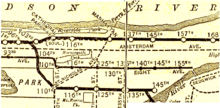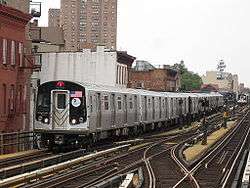IRT Lenox Avenue Line
| IRT Lenox Avenue Line | |
|---|---|
|
The 2 train serves the IRT Lenox Avenue Line south of 145th Street. The 3 train serves the entire line at all times. | |
| Overview | |
| Type | Rapid transit |
| System | New York City Subway |
| Termini |
Harlem–148th Street Central Park North–110th Street |
| Stations | 6 |
| Daily ridership | 126,471[1] |
| Operation | |
| Opened | 1904-1968 |
| Owner | City of New York |
| Operator(s) | New York City Transit Authority |
| Character |
Underground (Except for Harlem–148th Street) At-grade (Harlem–148th Street) |
| Technical | |
| Number of tracks | 2-3 |
| Track gauge | 4 ft 8 1⁄2 in (1,435 mm) |
| Electrification | 600V DC third rail |
The Lenox Avenue Line is one of the IRT lines in the New York City Subway, mostly built as part of the first subway line. It is a rather short line, only serving upper Manhattan.
Extent and service
The following services use part or all of the Lenox Avenue Line:
| Time period | Section of line | |
|---|---|---|
| 2 | all times | south of 145th Street |
| 3 | all times | full line |
The Lenox Avenue Line begins at the Harlem–148th Street station, which was formerly known as 148th Street–Lenox Terminal.[2] After the terminal, a track merges from the Lenox Yard, and the line heads south under Lenox Avenue. At 142nd Street Junction, the IRT White Plains Road Line merges (with an at-grade crossing between the northbound Lenox track and the southbound White Plains track), carrying through service from the Bronx.
At the north border of Central Park is the final stop on the line, Central Park North–110th Street. From there the line curves southwest under Central Park (one of three lines to do so, the other two being the IND 63rd Street Line and the BMT 63rd Street Line), and heads west under 104th Street. The line turns southwest and south to run underneath the IRT Broadway–Seventh Avenue Line, passing under part of the northbound platform at 103rd Street. After the center express track on the Broadway–Seventh Avenue Line ends by connecting to the two local tracks, the Lenox Avenue Line rises to become the two express tracks, with double crossovers to each local direction. The four-track Broadway–Seventh Avenue line then continues south through 96th Street, an express station and transfer point.
History
IRT Lenox Avenue Line |
|---|
Legend |

The line opened south of 145th Street just after midnight on November 23, 1904, as part of the IRT's original system. It was known as the East Side Subway or East Side Branch at the time, as it was the spur of the main line to the east side.[3] The first train ran from the line onto the IRT White Plains Road Line (known as the West Farms Branch or the West Farms Extension) just after midnight on July 10, 1905.[4] Soon after the line opened, it was speculated that it would bring prosperity to Harlem.[5]
Originally the line north of the 142nd Street Junction was only intended to be a yard lead to Lenox Yard, and sometime afterwards it was suggested to add a station at 145th Street.
The Harlem–148th Street station was opened on May 13, 1968 on land that had been part of the Lenox Yard; the station was originally called Lenox Terminal–148th Street.[6]
The line has always carried trains of two service patterns, currently designated 2 and 3. Prior to February 6, 1959, 3 trains switched to the local on the IRT Broadway–Seventh Avenue Line north of 96th Street. Afterwards, all trains running from the Lenox Avenue Line ran express.[7][8][9]
From March 2 to October 12, 1998, the tunnel that carried the 2 and 3 services was reconstructed along with the cracked invert (tunnel floor). This was done to correct a major water problem that had existed for many years due to underground streams located around the Lenox Avenue area that caused extensive water damage and seepage problems, resulting in extensive and severe delays due to track and roadbed flooding. The project cost $82 million.[10] Many 2 trains were rerouted via the IRT Lexington Avenue Line, while the 3 trains were rerouted to the 137th Street–City College station on the IRT Broadway–Seventh Avenue Line. Each of the two tracks that carried both the 2 and 3 services were alternately taken out of service, the 116th Street Station was closed, and supplemental shuttle bus service connecting to other lines in the area were provided for much of this time.[11][12]
From 1995 until 2008, the line's two northernmost stations, Harlem–148th Street and 145th Street, were served by shuttle buses during the late-night hours. Full-time service was restored on July 27, 2008.[13]
Station listing
The entire line is located in Harlem.
| Station service legend | |
|---|---|
| |
Stops all times |
| Time period details | |
| Station | Services | Opened | Notes | |
|---|---|---|---|---|
| Harlem–148th Street | 3 |
May 13, 1968 | Formerly 148th Street–Lenox Terminal | |
| connecting track to Lenox Yard | ||||
| 145th Street | 3 |
November 23, 1904 | Only first 5 cars platform No northbound entrance | |
| Merge from IRT White Plains Road Line at 142nd Street Junction (2 | ||||
| 135th Street | 2 |
November 23, 1904 | ||
| 125th Street | 2 |
November 23, 1904 | M60 Select Bus Service to LaGuardia Airport | |
| 116th Street | 2 |
November 23, 1904 | ||
| Central Park North–110th Street | 2 |
November 23, 1904 | ||
| Tracks continue as the IRT Broadway–Seventh Avenue Line express tracks (2 | ||||
References
- ↑ "Average Weekday Subway Ridership". MTA. Archived from the original on 28 March 2014. Retrieved 2 April 2014.
- ↑ "148 Street-Lenox Terminal (3)". subwaynut.com. Jeremiah Cox. Retrieved 2016-06-15.
- ↑ "East Side Subway Open — Train from 145th Street to Broadway in 9 Minutes and 40 Seconds". New York Times. November 23, 1904. p. 1. ISSN 0362-4331. Retrieved 2016-03-27.
- ↑ "Subway Trains Running From Bronx to Battery — West Farms and South Ferry Stations Open at Midnight — Start Without a Hitch — Bowling Green Station Also Opened — Lenox Avenue Locals Take City Hall Loop Hereafter". New York Times. July 10, 1905. p. 1. ISSN 0362-4331. Retrieved 2016-03-27.
- ↑ "History of Harlem — Harlem Heritage Tours & Cultural Center". Retrieved 2016-09-02.
- ↑ "IRT Passengers Get New 148th St. Station". New York Times. May 14, 1968. p. 95. Retrieved October 4, 2011.
- ↑ Levey, Stanley (January 26, 1959). "Modernized IRT To Bow on Feb. 6 — West Side Line to Eliminate Bottleneck at 96th Street". New York Times. p. 1. Retrieved 6 November 2016.
- ↑ "New Hi-Speed Locals 1959 New York City Transit Authority". Flickr — Photo Sharing!. Retrieved 2016-06-15.
- ↑ "Wagner Praises Modernized IRT — Mayor and Transit Authority Are Hailed as West Side Changes Take Effect". New York Times. February 7, 1959. p. 21. Retrieved 6 November 2016.
- ↑ "About NYC Transit — History". 2002-10-19. Archived from the original on 2002-10-19. Retrieved 2016-09-18.
- ↑ Newman, Andy (December 12, 1997). "Repairs to Lenox Ave. Tunnel To Affect Many Subway Lines". New York Times. Retrieved July 31, 2013.
- ↑ "Lenox Avenue Rehabilitation Brochure". thejoekorner.com. Joseph D. Korman. Retrieved 6 November 2016.
- ↑ "MTA | Press Release | NYC Transit | Service Enhancements on 3 Line". www.mta.info. Metropolitan Transportation Authority. July 24, 2008. Retrieved 2016-09-02.
External links
- nycsubway.org — nycsubway.org - IRT Lenox/White Plains Line





